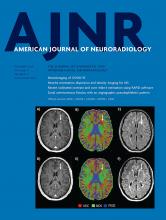Index by author
Kizilkilic, O.
- FELLOWS' JOURNAL CLUBNeurointerventionYou have accessTreatment of Ruptured Blister-Like Aneurysms with the FRED Flow Diverter: A Multicenter ExperienceM.A. Möhlenbruch, F. Seker, E. Özlük, O. Kizilkilic, E. Broussalis, M. Killer-Oberpfalzer, C.J. Griessenauer, M. Bendszus and N. KocerAmerican Journal of Neuroradiology December 2020, 41 (12) 2280-2284; DOI: https://doi.org/10.3174/ajnr.A6849
In a retrospective multicenter study, all patients treated with the FRED for a ruptured intracranial blister-like aneurysm between January 2013 and May 2019 were analyzed. In total, 30 patients with 30 ruptured blister-like aneurysms were treated. Immediate complete aneurysm obliteration with the FRED was achieved in 10 patients (33%). Of the 26 patients with follow-up, complete obliteration was achieved in 21 patients (80%) after 6 months and in 24 patients (92%) in the final follow-up (median, 22 months). The authors conclude that treatment of ruptured blister-like aneurysms with the FRED is safe and effective.
Kocer, N.
- FELLOWS' JOURNAL CLUBNeurointerventionYou have accessTreatment of Ruptured Blister-Like Aneurysms with the FRED Flow Diverter: A Multicenter ExperienceM.A. Möhlenbruch, F. Seker, E. Özlük, O. Kizilkilic, E. Broussalis, M. Killer-Oberpfalzer, C.J. Griessenauer, M. Bendszus and N. KocerAmerican Journal of Neuroradiology December 2020, 41 (12) 2280-2284; DOI: https://doi.org/10.3174/ajnr.A6849
In a retrospective multicenter study, all patients treated with the FRED for a ruptured intracranial blister-like aneurysm between January 2013 and May 2019 were analyzed. In total, 30 patients with 30 ruptured blister-like aneurysms were treated. Immediate complete aneurysm obliteration with the FRED was achieved in 10 patients (33%). Of the 26 patients with follow-up, complete obliteration was achieved in 21 patients (80%) after 6 months and in 24 patients (92%) in the final follow-up (median, 22 months). The authors conclude that treatment of ruptured blister-like aneurysms with the FRED is safe and effective.
Koontz, N.A.
- Head and Neck ImagingOpen AccessSecondary Otalgia: Referred Pain Pathways and PathologiesC.D. Norris and N.A. KoontzAmerican Journal of Neuroradiology December 2020, 41 (12) 2188-2198; DOI: https://doi.org/10.3174/ajnr.A6808
Kossorotoff, M.
- Pediatric NeuroimagingYou have accessRisk Factors for Early Brain AVM Rupture: Cohort Study of Pediatric and Adult PatientsL. Garzelli, E. Shotar, T. Blauwblomme, N. Sourour, Q. Alias, S. Stricker, B. Mathon, M. Kossorotoff, F. Gariel, N. Boddaert, F. Brunelle, P. Meyer, O. Naggara, F. Clarençon and G. BoulouisAmerican Journal of Neuroradiology December 2020, 41 (12) 2358-2363; DOI: https://doi.org/10.3174/ajnr.A6824
Kotsenas, A.L.
- Open AccessImaging Review of Paraneoplastic Neurologic SyndromesA.A. Madhavan, C.M. Carr, P.P. Morris, E.P. Flanagan, A.L. Kotsenas, C.H. Hunt, L.J. Eckel, E.P. Lindell and F.E. DiehnAmerican Journal of Neuroradiology December 2020, 41 (12) 2176-2187; DOI: https://doi.org/10.3174/ajnr.A6815
Ku, J.C.
- EDITOR'S CHOICENeurointerventionYou have accessEndovascular Cerebral Venous Sinus Imaging with Optical Coherence TomographyC.R. Pasarikovski, J.C. Ku, J. Keith, J. Ramjist, Y. Dobashi, S.M. Priola, L. da Costa and V.X.D. YangAmerican Journal of Neuroradiology December 2020, 41 (12) 2292-2297; DOI: https://doi.org/10.3174/ajnr.A6909
Endovascular optical coherence tomography imaging was feasible in this preclinical animal study. Adoption of this imaging technique in the human cerebral venous sinus could aid in the diagnosis, treatment, and understanding of the pathophysiology of various diseases of the sinus.








